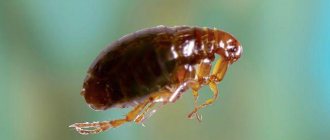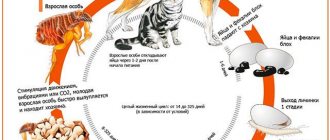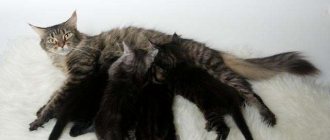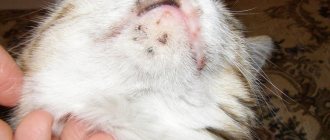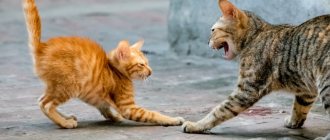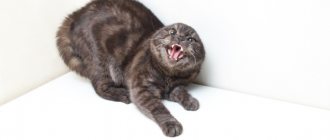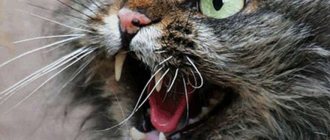Animals, like humans, are susceptible to various diseases, regardless of species, breed or size. Illnesses can affect not only wild fauna, but also pets living in an apartment.
The most common nuisance among animals is fleas, which are most often found in long-haired pets, such as cats. This, in turn, can cause inflammation - an allergy to the saliva of parasites. Moreover, for its development, just one flea bite is enough, because the saliva of these parasites contains many types of allergens to which cats are very sensitive.
Important: the disease can occur not only in long-haired breeds, but also in animals with short hair and even hairless ones.
Fleas in cats: morphology and development cycle
The cat flea is one of the parasites of animals that can also attack humans. She looks like a tiny dark insect without wings. Body size: 0.5–5 millimeters. However, a female engorged with blood can swell up to 16 millimeters.
Fleas parasitize cats and rats. When attacking a person, it selects the area of the legs below the knee.
The lifespan of a flea depends on living conditions and usually ranges from 3 months to 1.5 years.
Favorable conditions for fleas
| Temperature | 20–25 ºС |
| Air humidity | 60 % |
| Humidity | 70 % |
Fleas breed all year round. One female is capable of laying from 2 to 15 eggs at a time. Thus, an individual can reproduce about 500 throughout its life.
Important! This number is arbitrary, since for the eggs to fully mature, the female needs to fully feed on blood.
Places for laying can be different: cracks in the floor or walls, bedspreads or animal beds, food waste, soil, pet hair.
Stages of flea development:
- Egg. A tiny white dot. Size: 0.5 millimeters. Cycle: from 2 days to 2 weeks.
- Larva. Resembles a worm with segmented hairs. Size: about 5 millimeters. It is mobile, growing by eating feces, blood or plant waste. Cycle: from 9 days to 8 months.
- Doll. Looks like a larva in a cocoon. Cycle: from 6 days to 1 year.
- Imago. Is a full-fledged adult.
What does a flea bite look like? photo
These fleas usually live in the habitats of rodents and birds; they are capable of not only biting skin and drinking blood, but also settle under the nails and lay eggs there. The larvae grow in this environment, feeding on the resulting pus and surrounding tissue. Itching, swelling, and irritation appear at the site of the lesion. Doctors diagnose sarcopsillosis.
How do fleas appear on a cat?
The appearance of fleas in cats can be caused by a number of reasons:
- The animal loves to explore the entrances and basements of the house. After all, rooms without ventilation with the same level of humidity and a minimum of light are ideal conditions for the reproduction of fleas.
- Penetration of insects from neighboring apartments. Fleas can move through the thinnest cracks, so there is only one way to protect yourself from uninvited guests after getting rid of them - to make high-quality repairs.
- Contact with an infected cat – even minimal animal contact is enough.
- Carrying fleas on clothes. Unfortunately, the owner can infect the animal on his own, and in this case it is impossible to protect himself from undesirable consequences.
- Inadequate cleaning after treatment of the cat. Simply washing the floors and bowls is not enough: eggs or larvae may remain in furniture, carpets or the animal's bed. If fleas appear in the house again, repeated treatment and better cleaning of the premises is required.
Diagnosis of the appearance of dermatitis
The owner can independently determine the presence of fleas in a pet by changing behavior and examining its fur. But only a veterinarian can make an accurate diagnosis - an allergy to parasites - based on the results of laboratory tests and examination of the animal. To clarify the primary diagnosis, a sample is taken from the affected area of the skin and examined. In addition, an allergen test is prescribed.
Allergic dermatitis as a negative reaction to a large number of fleas has similar symptoms to a number of other diseases. Therefore, differential diagnosis is required. Allergy to parasites must be distinguished from diseases such as lice, sarcoptic mange, alopecia, and pemphigus foliaceus.
Dermatitis is a skin reaction that is a symptom and not a disease itself.
How dangerous are fleas on a cat?
In cats, fleas can cause both minor health problems and very serious problems. In the first case, the animal is bothered by itching, so it begins to actively scratch: wounds and abrasions appear.
If the owner rids the cat of fleas immediately, there will not be much damage to health. However, in advanced cases, dermatitis may develop. In addition, cats tend to bite and swallow fleas, which is dangerous due to intoxication, helminth infection and even anemia.
Flea allergic dermatitis
Dermatitis in cats is provoked by flea bites and subsequent active scratching. Animals that are prone to allergies are at risk.
Flea saliva consists of complex compounds that are not dangerous in small doses. But if a cat is repeatedly bitten, it may develop hypersensitivity.
Signs of flea dermatitis:
- itching;
- redness;
- scratches, open wounds;
- hair loss.
The disease progresses quickly, so it is important to start treatment as soon as possible. You can also deal with fleas at home. The main thing is an integrated approach.
Important! Flea dermatitis is dangerous due to complications that will inevitably arise in the presence of open wounds. After all, they are a natural environment for bacteria. If an unpleasant odor begins to emanate from the animal, this is a sure sign that the wound has a yeast or bacterial infection.
Anemia in kittens
Anemia is a pathology in which there is a simultaneous drop in the level of red blood cells and hemoglobin in the blood. It can develop in an adult animal. However, it is most dangerous for a kitten’s fragile body due to the likelihood of death.
Anemia can be caused by various reasons. One of them is flea infestation.
Signs of anemia in a kitten:
- weakness;
- pallor/cyanotic/yellowishness of the mucous membrane;
- refusal to eat;
- weight loss;
- dyspnea.
Anemia is a serious disease. It cannot be cured by simply getting rid of the original source, which is cat fleas. Therapy includes taking various medications that are aimed at restoring normal blood composition. And only a veterinarian can prescribe them.
Infectious and parasitic danger of fleas: hemobartonellosis and dipilidia
Hemobartonellosis is an infectious anemia. It is provoked by microorganisms carried by fleas and mosquitoes. Unlike classical anemia, a malfunction of the body occurs due to the fact that microbes directly destroy red blood cells.
The disease is dangerous because it occurs secretly. Symptoms may not appear for up to 5 months after infection.
Signs of hemobartonellosis:
- decreased activity;
- loss of appetite;
- weight loss;
- pallor of the mucous membrane;
- heat;
- enlarged spleen.
Important! Hemobartonellosis requires complex treatment, which may include blood transfusions. And even if the cat recovers, liver or kidney failure may persist.
Dipilidiosis is a disease caused by the cucumber tapeworm. The parasite is white-gray or pink in color. It can reach 70 cm in length and 3 mm in width. A cat can become infected with dipilidia by eating adult fleas - they are the carriers of the pathogen larvae.
Signs of infection:
- weight loss;
- changes in eating behavior;
- The cat is constantly nervous.
Important! Dipylidiasis is also dangerous for humans.
Why does flea dermatitis develop in cats?
Individuals older than 1 year are more often susceptible to this disease than kittens under 12 months. But in the second case, the invasion almost always ends in death. The reason is weak immunity, which often cannot cope with the disease.
This kind of skin inflammation in cats doesn’t just happen. The most common causes of the disease are:
- warm season;
- dirt from the street;
- unsanitary conditions;
- contact with other animals;
- decreased immunity;
- self-walking
The peak of diseases occurs in the summer season, when the air temperature reaches its maximum, which provokes an increase in the activity of parasites. This usually happens in July-August. At this time of year, it is extremely undesirable to let your pets outside. Especially when it comes to southern cities. For a disease such as flea allergy in cats, Rostov-on-Don, Krasnodar, Anapa and other settlements in the southern regions are an ideal place for spread.
Fleas that cause the disease can enter the house, for example, with dirt on the soles or on outer clothing.
Outdoor animals, which are almost always infested with fleas, are especially dangerous for cats living in apartments. Therefore, walking pets on the street should only be done under close attention and on a harness. It is for this reason that self-walking cats should be reduced in time as much as possible, especially in the summer.
But not all pets, even if they have fleas, can become infected with this disease. Usually it is dangerous only for those cats that have a decrease in immunity. Most often this happens after an illness, as a result of which the protective functions of the animal’s body are significantly reduced.
Symptoms of flea infestation
It is difficult to detect fleas at the initial stage. However, this is quite possible if you examine the cat’s stomach. It is in this area that, upon careful examination, insects or their feces can be seen.
Signs of flea infestation:
- active scratching;
- the cat is worried, reacts sharply to stimuli, meows;
- loss of appetite;
- weakness, reluctance to play.
If you do not get rid of fleas on a cat in time, the animal will begin to lose weight, and ulcers will begin to form at the bite sites. In addition, advanced infestation is associated with the presence of bald spots in the fur.
Consequences of a flea bite
- An allergic reaction to an enzyme that prevents blood clotting can vary. From rashes, itching, redness and swelling to anaphylactic shock
- The flea is a carrier of a huge number of dangerous diseases.
- Itching caused by a flea bite forces a person to scratch the wound, thereby creating the risk of contracting secondary infections.
Diseases whose pathogens are transmitted by parasites themselves pose a huge danger. Their specificity is largely determined by the type of blood-sucking insect.
Diagnostics: how to determine that a cat has fleas?
Before you start fighting fleas, you need to make sure that it is they that are bothering your cat:
- It is necessary to pay attention to where exactly the cat is itching. Fleas are active on the sides and back (or on the whole body if the infestation is advanced), and ticks are active behind the ears and in the groin.
- Flea eggs and feces in a cat. If white and black dots are observed on the skin and at the base of the hair, it means that there are adult fleas on the animal.
- Skin irritation. Ulcers, scratches, and redness are typical signs of an advanced flea infestation.
- Detection of fleas by visual inspection. It’s easy to understand that it’s a flea in front of you. It has a rounded body 0.5 millimeters long and very thin long legs. You can find insects if you simply move the fur in different directions. In addition, fleas will begin to jump off the cat while bathing - no other insect can do this.
The first signs of allergies
In a cat, a flea allergy can occur in different ways, depending on the individual characteristics of the body. Some animals react more acutely, while others have milder symptoms. This depends on the number of parasites, the state of immunity and the age of the pet. Kittens are the most susceptible to allergies.
Allergy to flea bites in cats has the following primary symptoms:
- Severe skin itching. The cat is constantly itching, trying to get to hard-to-reach places by biting the skin with its teeth.
- The appearance of alopecia in certain areas. Inflammatory lesions appear on damaged skin, affecting the hair follicles. This leads to active hair loss.
- Formation of bumps on the skin. Papules appear in the place where the flea bites were. They begin to become inflamed, causing discomfort.
- Change in skin color, appearance of pigment spots.
- Severe swelling of the skin.
The cat develops dermatitis, which leads to severe cat itching and skin lesions. If the allergy is not identified and treated in a timely manner, the animal's condition will worsen. Associated symptoms will appear: cough and frequent sneezing, clear discharge from the eyes.
What to do if your cat has fleas: treatment methods and review of remedies
You can remove fleas from a cat using different means. They come in different forms:
- drops;
- shampoos;
- sprays;
- collars;
- pills.
In addition to common sprays, shampoos, and tablets, there are even ultrasonic repellers that hang as a keychain on an animal’s collar. However, not all of them are effective.
Most flea remedies have a prolonged action, that is, the effect lasts for a long time (1-6 months).
Before you start removing fleas, it is important to consider a number of points:
- age of the cat;
- whether the pet is sick (a weakened animal cannot be treated with chemicals);
- tendency to allergies to the components of the drug.
For kittens, pregnant and lactating cats, you will need to buy specialized products.
Fleas on a cat - drops
As a rule, drops require a single use. Depending on their composition, they have a destructive or repellent effect. Products containing insecticides are the most effective, but they must be used strictly according to the instructions (the dosage is calculated based on the weight of the cat). Drops with essential oils are not so toxic, so they are suitable for weakened animals, but in case of advanced infestation they will not be able to help.
List of effective drops:
- Advantage.
- Leopard.
- Advocate.
- Frontline Combo.
- Stronghold.
The advantages of drops include speed (fleas die in 1–2 days), as well as versatility (many drugs simultaneously fight lice, lice and ticks). Disadvantages - the need to prevent the cat from coming into contact with water and small children. In addition, many drops are not suitable for newborn kittens or pregnant or lactating cats.
Important! As a rule, the drops are valid for 3 months. After this period, the animal will need to be processed again.
Fleas on a cat - shampoos
Shampoos kill fleas if you wash your cat once, but do not have a delayed effect. Like drops, depending on the composition, they either repel fleas or destroy them.
List of effective shampoos:
- Outpost.
- Beaphar.
- Mr. Bruno.
- Mr. Kiss.
- Rolf Club.
The advantage of shampoos is that they can be used not only for their intended purpose, but also to wash rugs from beds or wash toys. They are suitable for kittens and pregnant and lactating cats, as long as they do not contain insecticides.
Disadvantages of shampoos: the fragility of the effect and the risk of poisoning the animal if the product is not thoroughly washed off the fur.
Sprays
Using a spray you can remove not only fleas, but also their larvae and eggs. In addition, products of this kind are effective against lice, ticks and lice-eaters.
When choosing a drug, it is worth considering that they come in 2 types:
- for processing animals;
- for processing the room.
List of effective sprays:
- Leopard.
- Celandine.
- Frontline.
- Hartz.
- FitoDoc AB3.
Sprays can kill fleas in a single application, even with an advanced infestation. However, this effectiveness is explained by strong toxicity - if used incorrectly, they can harm the animal and provoke allergies. Although there are drugs that are suitable for 2-day-old kittens, for example Frontline.
Important! Sprays are used strictly according to the instructions. It is not enough to simply treat the animal in a ventilated area. You need to put on your work clothes and then wash them thoroughly. You should also make sure that the drug does not get into your pet’s eyes.
Collars
Collars are also used to kill fleas or repel them. In the first case, the tape is impregnated with insecticides, in the second - with vegetable and essential oils. These points should be taken into account if the animal is still small or is bearing offspring.
Adult cats and kittens over 3 months of age can wear insecticide collars. For kittens, pregnant and lactating cats - with esters.
List of effective tapes:
- Leopard.
- Doctor Zoo.
- Celandine.
- Beaphar.
- Hartz.
Collars last a long time - up to 6 months. There are also models with complex action: against fleas, lice, ticks and lice at the same time. They are not as toxic as sprays, but are not able to cope with insects if the infestation has reached a critical stage. In this case, it is better to apply drops or spray, and then apply tape to the already treated cat.
The key to the effectiveness of the collar is proper wearing. The tape should not fit tightly. A finger should fit freely between the collar and the animal's neck. It is also important to cut off any excess tape that remains after the fastener is attached. The cat may bite it, which will cause poisoning.
Interesting! Manufacturers have long moved away from the monotonous production of black collars. Nowadays you can find ribbons in a variety of colors on the shelves. Now, in addition to protection against fleas, there is also an aesthetic point: you can choose a collar that matches the color of a particular cat.
Pills
Tablets stand apart among flea control products. This is a last resort when the animal is in a neglected state. External preparations are not suitable if the cat has dermatitis and other skin lesions. It is in such cases that it is necessary to resort to tablets.
However, treatment at home cannot be done without consulting a specialist. It should be understood that an animal with a serious infestation requires the help of a veterinarian. The list of drugs in tablet form is quite wide.
There are products for one-time use, and there are those that are taken in a course. There are drugs only against fleas, and there are drugs against fleas and ticks at the same time. Therefore, only a veterinarian can choose the right remedy after examining the animal.
List of known tablets:
- Comfortis.
- Bravekta.
- NexGard.
Important! Manufacturers produce dog flea tablets. They should not be given to cats, even if we are talking about drugs for small breed dogs. Many medications that are intended for canines depress the cat's nervous system.
Treatment of dermatitis in cats
If your veterinarian has diagnosed flea dermatitis in cats, treatment should begin immediately to prevent it from progressing to a serious stage.
You need to start acting by eliminating the root cause - parasites. To remove fleas, you can use various methods - both folk remedies and products sold in pharmacies.
Antihistamines
They are aimed at eliminating signs of allergies - itching, swelling, redness. Typically, the duration of taking such medications does not exceed one to three weeks. Only a veterinarian can calculate the duration.
For convenience, they are usually mixed with food or water. Some anti-allergy drops and tablets suitable for humans can also be given to animals. These, for example, include Zodak, Suprastin or Zyrtec. In particularly severe cases, the doctor may prescribe injections.
Important: antihistamines are effective only with complex treatment. They do not eliminate the cause, but only help remove the symptoms.
Hormonal
They are usually prescribed for severe cases of the disease and are first given in large quantities to dull the manifestations of the disease, gradually reducing the dose.
Hormonal medications have a lot of side effects, so they are given only when other treatments are useless. Such troubles include:
- decreased immune function of the body;
- metabolic disease;
- problems with the digestive tract.
Because medications in the form of tablets or drops are difficult to administer to cats, creams and gels that are used externally, such as Stop Itching, are sometimes prescribed as an alternative.
Diet
To restore strength after an illness, an animal needs special cat food that will help it support its immune system. Food high in Omega-3 should be given as an additional nutrition to the main one. It is also necessary to completely exclude chicken, beef, lamb and food made from these products for a while - due to strong allergenicity.
Drops
They are usually used to eliminate the cause of dermatitis in cats - fleas. They are applied externally - to the withers, so that the animal does not remove the medicine when licking the fur. In addition, it is unacceptable for it to enter the animal’s body.
The drops are convenient because a small dose is required to remove all types of skin parasites; they allow you to get rid of them as quickly as possible, literally within 1-2 days from the moment of application. Such drops include, for example, “Beafar”, “Frontline” or “Advantage”.
Powder
It is used to heal sores caused by scratches on the body of an animal. When using it, the crusts heal faster, and clean and healthy skin appears in their place. In addition, the composition of the powder is aimed at reducing itching, which also has a beneficial effect on wound healing.
Collar
It is the most common type of treatment for parasites in cats. True, such a flea trap is more used for prevention, because it does not allow them to settle on the cat’s skin, repelling them with their specific smell.
And the composition with which the material is impregnated can also cause allergies, but the risk of its occurrence is much lower than flea infestation. The most common are “Bars” and “Clandestine”.
Shampoo
During the treatment process, most veterinarians, along with other methods, prescribe the use of special shampoos. Their composition is more aggressive than regular ones, because it is aimed at destroying parasites. It is recommended to use them only for pets older than six months. Cats younger than this age should be treated with different techniques. The most popular brands among such shampoos are “Clandestine”, “Lugovoy” and “Mskiss”.
Spray
To get rid of fleas and the consequences of their life on the animal's body, sprays are often prescribed (Bolfo, Bars, Frontline). The advantage of using this drug is that it covers a large area of the affected area and penetrates into its deepest layers. In addition, the spray is usually sold in large quantities, which allows it to be used for more than one month.
Home disinfection
After treating a cat, an important step in the fight against fleas is treating the home.
Professional disinfection
Professional disinfection is the most effective. A team of specialists will arrive at your home, assess the sanitary condition of the home and choose the most appropriate disinfection method. Typically, disinfection is carried out either using a heat gun or using chemicals. The owner is only required to prepare the house and pay for the services.
Important! A few days after professional treatment, you may find fleas on the floor. However, do not think that the service was provided poorly. Insects could easily remain in the cracks and gaps, but upon contact with the treated surface they quickly die. A similar phenomenon can be observed within 5 weeks after the visit of specialists.
Disinfect yourself
You can disinfect your home yourself using a spray or powder.
Processing stages:
- Remove children, animals and indoor plants from the house.
- To throw out the trash.
- Move furniture away from the walls. Remove from the walls all objects that hang on them.
- Put on work clothes.
- Spray the entire home, including carpets, upholstered furniture, clothing, shoes and bedding. Particular attention should be paid to the animal's belongings.
- Close doors and windows. Leave the house for several hours, ideally all night.
- Upon return, ventilate the rooms well, wash all surfaces and wash all items that have been processed.
Unlike sprays, powders are less effective, but when using them you do not need to leave your home. It is enough to scatter the granules in places where fleas are most concentrated (cracks, areas behind the baseboard). Upon contact with the granular substance, not only adult individuals die, but also their larvae and eggs.
Prevention
To minimize the risk of the disease, special attention should be paid to its prevention.
In order to prevent the occurrence of dermatitis in cats, the following measures must be taken:
- Keep the house clean. To do this, every time you come home from the street, you need to wash your shoes and clean your outerwear. After these manipulations, you should put things in a closed space, for example, a closet.
- The cat should wear a neck strap regularly. It is an excellent remedy for repelling skin parasites, because its composition is aimed specifically at destroying them. In addition, such a device is the most inexpensive method to protect your pet from fleas.
- Avoid self-walking of the animal, especially in the warm season.
- Periodically carry out a preventive examination of the cat's skin for the presence of parasites.
- Visit your veterinarian regularly.
- Do not violate the flea treatment schedule (2 times a year).
When a disease such as flea allergic dermatitis is detected in cats, timely treatment plays a huge role, since its health condition depends on the speed of reaction of the animal’s owners.
How to remove fleas from a cat at home using folk remedies: myths and reality
Myth #1: Wormwood repels fleas. This is certainly true. You can pick up several armfuls and place them in different corners of the house. There will be fewer fleas, but the effect will only last until the plant dries out. In addition, the smell of wormwood is specific even to humans. So there is a risk of not only fleas leaving the house, but also guests and household members.
Myth No. 2: Essential oils will save you from fleas. Peppermint, pine, eucalyptus and lavender are safe for cats. As a rule, you can find advice on the Internet that says that you need to dilute a few drops in a glass of water and treat the animal with the resulting solution. Next, the oil concentrate is dripped onto sponges or napkins, which are laid out in different places in the house. However, it is worth considering here that essential oils do not kill insects, but only repel them. So there can be no talk of complete deliverance. In addition, odors disappear quickly: the animal will need to be treated daily, as will the napkins.
Myth #3: Let there be salt and soda. The saline or soda solution is safe for kittens and pregnant and lactating cats. It is prepared like this: 100 grams of the substance are diluted in 1 liter of warm water. It is used according to the following scheme: the animal must be kept in the resulting solution for 10–15 minutes, after which it is washed with baby soap, dried and combed. You can also wash the floors in your apartment with this solution and wash your pet’s bed. However, there are controversial points here too. You can’t keep the whole animal in the solution: the head will still be above the water, which means insects may well run across it. Washing a room with salt is associated with stains, so washing and re-washing is still necessary afterwards. And such solutions are effective only for 3-4 days, and then require repeated use.
Which method of fighting fleas deserves attention is determined by everyone for themselves. However, it is worth understanding that traditional methods either simply repel insects or act for an extremely short time. Therefore, you can resort to them only if the animal is allergic and categorically cannot tolerate the effects of chemicals. However, after this, it is advisable to temporarily transfer the pet to friends and disinfect the home with chemicals.
Treatment regimens for cat allergies
Ridding an animal of parasites is not a sufficient measure to treat allergies. Depending on the symptomatic picture and the presence or absence of complications, appropriate drug therapy is selected.
Symptomatic therapy
For symptomatic treatment, drugs mainly from the hormonal pharmacological group are used:
- Prednisolone. The dosage ranges from 0.5 to 1 mg for every 1 kg of animal body weight. Prednisolone is used in tablet form.
- Dexaforte. The amount of the drug is 0.05 ml per 1 kg of weight. Dexaforte is used to treat animals that have excessive aggression due to allergies, and pets that spend a lot of time outdoors, where the risk of re-infection is high.
In addition, it is recommended to give antihistamines such as Tavegil, Zyrtec and Suprastin.
Prednisolone is a white or white with a slight yellowish tint crystalline powder in odorless tablets.
If a cat has constant access to the street, despite the treatment, she has a risk of re-infection with fleas and developing allergies. To avoid this, veterinarians recommend immunotherapy – introducing a small amount of an allergen into the animal’s body.
When a small amount of an irritating substance is constantly introduced into the body, the cat’s immune system begins to actively produce antibodies. Over time, their concentration increases, and the body ceases to be sensitive to the allergen.
Immune therapy in cats in 85% of cases gives a positive result, which consists in the complete elimination of allergies, even in the presence of fleas in the fur.
Antibiotics for severe cases
Antibacterial drugs are prescribed if the cat, due to an allergic reaction and severe scratching, has inflammatory processes (purulent) on the skin, and an infection has entered the wounds.
Antibiotics are substances that inhibit the growth of living cells, most often prokaryotic or protozoan.
Antibiotics for cats can only be prescribed by a veterinarian. Drugs with a wide spectrum of effects are used. The duration of the course is 14 days.
Skin restoration products
Allergies primarily negatively affect the condition of the coat: it loses its shine and strength, and actively falls out. Bald spots appear on it. Treatment of the pathological condition includes careful and proper care of the coat. To quickly return it to its normal state, special vitamin and mineral supplements are used.
They should contain fatty acids:
- Nordic Omega-3 Naturals;
- Medizinal Dorschlebertranl.
Additionally, special drops for wool are prescribed: Essential-6 or Allerderm.
If the owner feeds the cat with finished industrial products, it should be replaced with dry food, which contains all the elements necessary for hair restoration. Recommended foods with medicinal effects: Derma ProPlan Plus, Hill's z/d, Coat Formula and Royal Canin Skin.
Flea bite symptoms
If the listed symptoms are well expressed, supplemented by profuse rashes in the area of the bites, their suppuration, ulcers in the mouth and throat, enlarged lymph nodes, fever and headache, insomnia, we can talk about the presence of a disease such as pulicosis, which is understood as a dermatological disease caused exclusively flea bites. This disease is usually caused by human fleas.
- Stitching sharp pain at the moment of the bite.
- Itching from a flea bite, more pronounced than from a mosquito bite.
- Formation of small tumors.
- The location of the bites is on the legs and occasionally in other places.
- A series of bites characteristic of these parasites.
Prevention of feline dermatitis
In order to prevent the formation of flea allergies in cats, as well as dermatitis and other complications, the pet owner performs the following actions :
- does not let the cat outside if it has a flea allergy;
- Do not walk your pet in places where there is high air humidity. After all, it is in such areas that fleas live for a very long time;
- treats cat fur with specific anti-flea drugs once every 1 month. Moreover, such products cannot be used if they have already expired;
- puts a flea collar or a special flea collar on the pet;
- regularly examines the pet - checks for the presence of various types of fleas on the cat;
- more often treats the entire space in the corridor near the front door with specific long-acting products;
- carries out wet, thorough cleaning and treats carpets with insecticidal agents against fleas;
- If allergic feline dermatitis develops, take your pet to an appointment with the attending veterinarian.
If the pet's condition does not improve, then it should be immediately shown to the attending physician. In such a situation, the veterinarian takes a skin scraping from the infected animal and prescribes the necessary anti-flea medication from it.
Moreover, pet owners should not use anti-flea medications on their own without first visiting a veterinarian. After all, some of them lead to possible side effects.
In addition, if you do not go to the veterinarian in a timely manner, the flea allergy becomes chronic, or the cat develops dangerous complications, which often lead to its death. This also should not be allowed.
